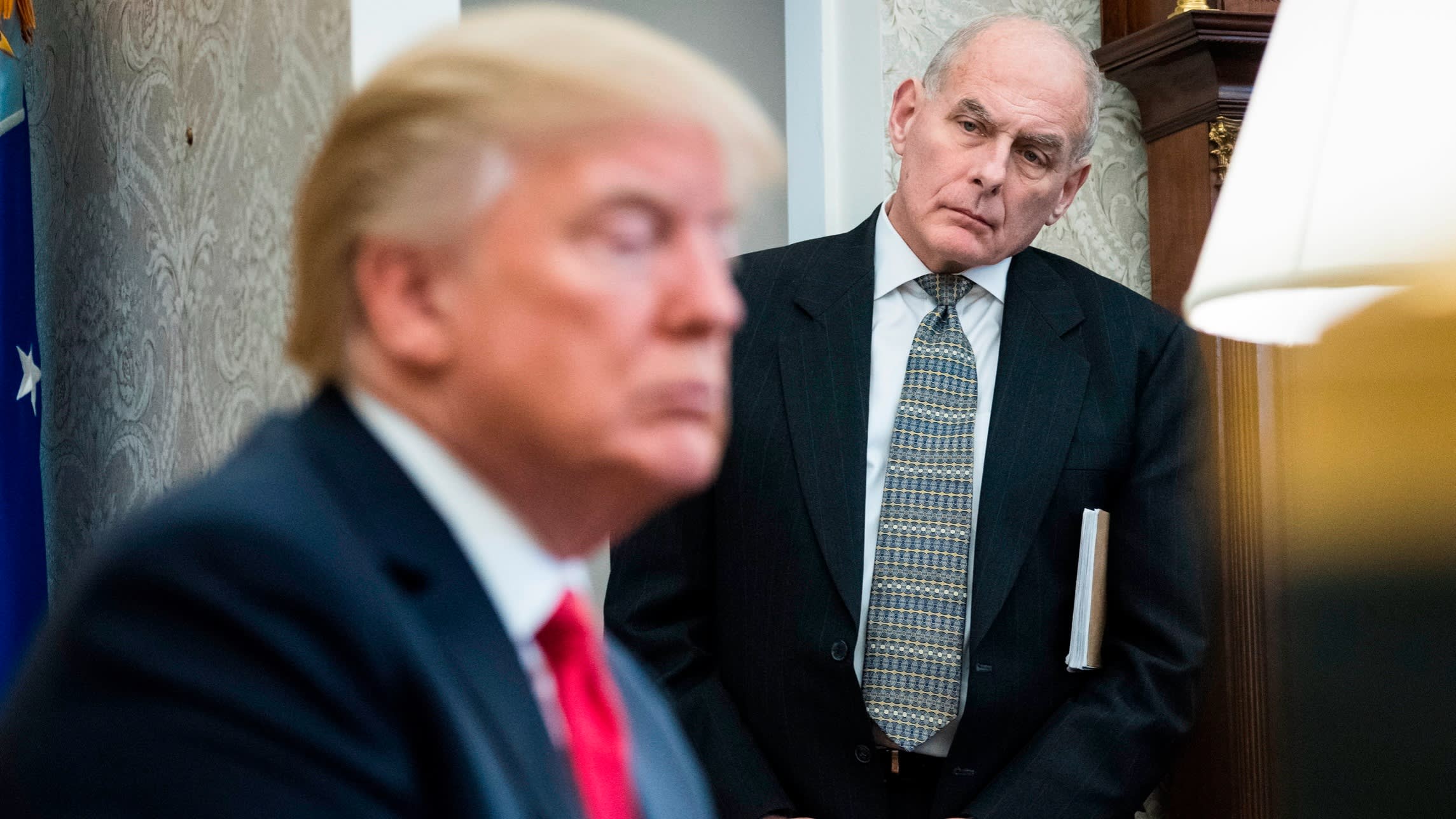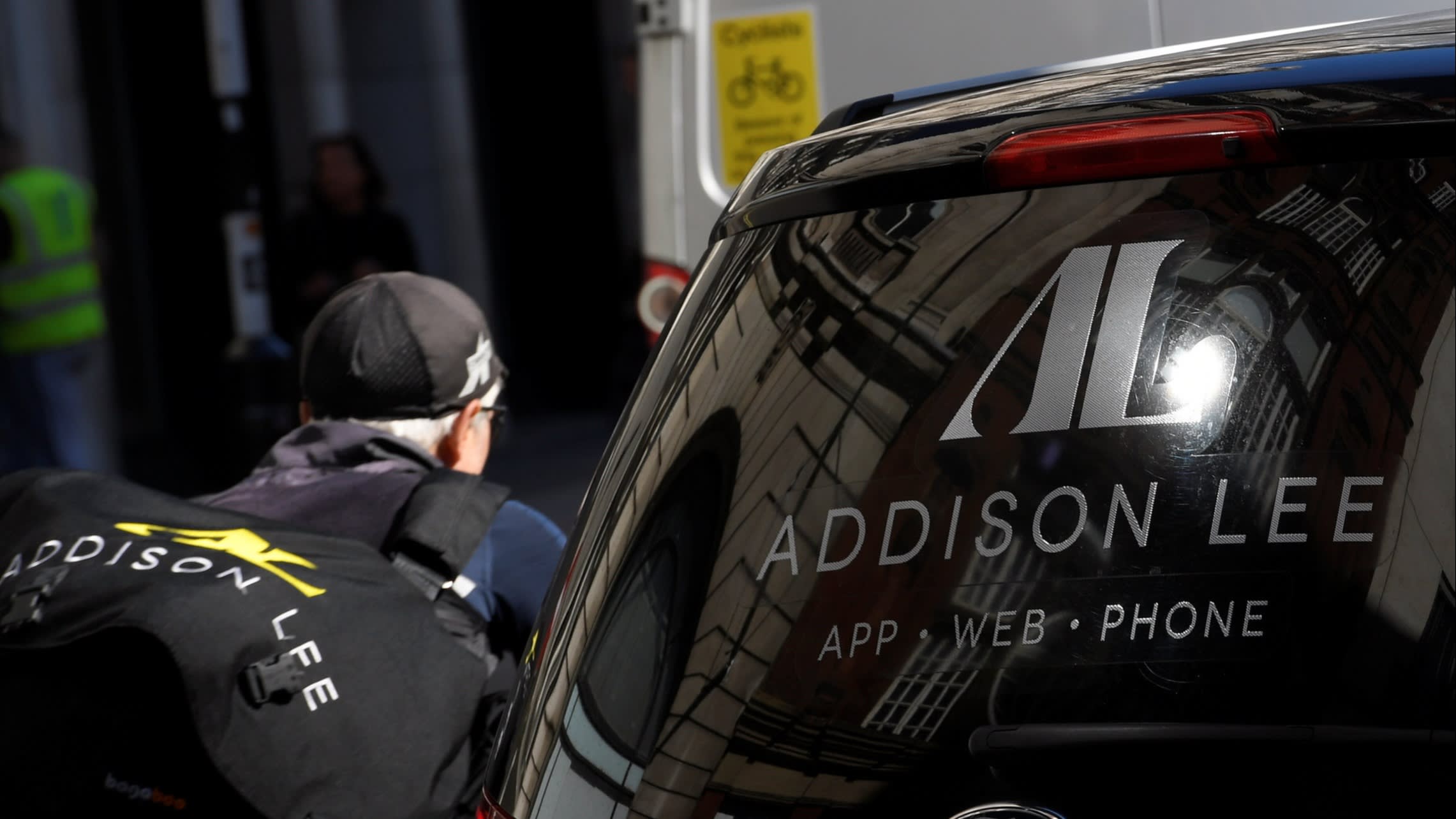Business
Trump’s ex-chief of staff says he is a fascist and would govern as a dictator

Four-star US General John Kelly’s claims were reported in blockbuster comments to The New York Times
Business
Ports, planes and power grids: investing in the infrastructure boom

Family offices’ love of tangible assets mean that most will be tempted to invest in Europe’s crumbling infrastructure, but there are warning signs regarding political risk and product quality.
Infrastructure is a new buzzword across Europe. A recently elected Labour government in the UK is doing its utmost to reignite a long-extinguished industrial flame, fuelled by a raft of new infrastructure investments.
These include Middle Eastern logistics giant, DP World, pumping £1bn ($1.3bn) into shipping berths and warehouses at the London Gateway port; Spanish utility Iberdrola injecting £10bn into offshore wind farms; and a £1.1bn Stanstead Airport investment, spanning terminal expansion and construction of a new solar farm.
While some wealthy families are keen to get involved in the boom, others are more hesitant, troubled by perceived political instability and lack of suitable investment vehicles.
“There are big problems in infrastructure, not just in the UK, but also in Germany and Italy,” says Chris Kaehelin, CEO of the Henley & Partners consultancy, which helps wealthy families relocate to different jurisdictions. “Bridges are also collapsing in the US, where roads and railroads require huge resources, as there is not enough ongoing investment.”
His fear is that because wealthy families are leaving the UK, due to a of lack of investment in infrastructure in transport and health services, a vicious circle is being created, because it is precisely these investors who are most likely to inject funds into construction efforts.
“A lot of people are thinking of leaving the UK, not just for non-dom reasons, but the general direction of the country is not feeling favourable for international wealthy families,” he says. “Wealthy businesses want to invest in the infrastructure around them. No governments should chase away wealthy people, as they are the ones who drive investments. When they leave, the investments leave too. They create jobs and bring in innovation.”
Water treatment
Most investment players say these investments have started, even though they may be moving without the much-needed momentum being hyped by European governments.
“Infrastructure is not at the level that it will have to be for how we operate our economies in the future,” says Nannette Hechler-Fayd’herbe, chief investment officer for Emea at the Lombard Odier Group in Geneva.
“If you think about it, some infrastructures in developed markets are very old indeed. Water treatment and distribution infrastructure in the UK in the City of London dates back nearly 100 years. That’s why we are looking at all types of infrastructure, where companies are participating in increased spending.”
This includes both direct investment in projects and buying into listed companies participating in the boom. Electric vehicles and charging networks which support them are of particular interest at Lombard Odier.
“Infrastructure in the UK remains a huge investment theme for asset managers and there is a significant number of opportunities for Infrastructure debt managers, echoed by institutions looking to invest in this asset class,” says Jean-Francis Dush, managing director of Edmond de Rothschild Asset Management in the UK and investment director of the group’s BRIDGE platform, investing in infrastructure projects linked with sustainable development and ESG principles.
“Large family offices are also interested and some debt products with double digit returns may attract their liquidity and bring additional funding to the UK’s infrastructure projects.”
He draws attention to investments including BRIDGE’s Yield Plus Growth strategy, which supports growth of projects in energy and digital transition spheres. “ESG is embedded in infrastructure,” says Mr Dush, whose funds are regulated under Article 8 of the March 2021 EU SFDR Directive.
“ESG is incorporated in our investment process from sourcing, structuring specific covenants, impact measurement of CO2 emissions avoided and alignment to the 2050 global warming reduction targets, plus reporting of each asset invested.”

Energy transition
The energy transition, according to Mr Dush, is happening across all infrastructure sectors, including renewables and sub sectors such as battery storage, hydrogen, transport and green mobility, digital infrastructure, and decarbonisation of utilities.
Investments in wind and solar power are among the most attractive for family offices. “This has become part of the core infrastructure play and there have been significant opportunities for almost three decades,” says Mr Dush, referring to the EU Fit for 55, which aims to decrease CO2 emissions by 55 per cent by 2030. “This has further accelerated the growth of renewable energy and is also creating the need for battery storage to manage the intermittent production and feed a constant flow to the grid and users,” he says.
Middle Eastern families in particular are interested in renewable energy and electric cars, although there is a desire to see vehicles manufactured more cheaply in Europe, to counteract current Chinese dominance of this market, says Sohail Jaffer, managing director of Genesis Consulting in Luxembourg, and former regional head of alternative investments at Citi.
“Renewable energy is a variation on the real estate theme, because it’s something you can touch and feel, which is infrastructure,” he says. “It’s not about intellectual or property rights. These guys like to be able to have tangible assets.”
While most wealthy investors are already overweight in their real estate allocations, they are generally willing to consider extra allocation to other so-called “real” assets, says Paul Whelan, director of UK wealth management for Swiss private bank Mirabaud.
“The richest investors like to see something tangible, adding a broader value to society, and they like that. But the challenge is that it’s a long-term investment, with a seven-year lock-in period to generate returns.”
He previously worked at Credit Suisse, where direct infrastructure investments were typically rolled into structured products. “We bought into a Spanish toll road, that was guaranteed to generate returns, but then Covid happened and no one was using the road,” he recalls. “But if it works, it’s a very effective use of capital. It has a low correlation to the liquid market experience, especially in recent times when that has been so tech oriented.”
A variety of assets can be attractive for wealthy families, suggests Mr Whelan. “There are the classic heavy infrastructure plays like trains, roads and planes, but there is also much more modern infrastructure, which will transform economies, including telecoms and substack security, plus crossover with the green movement.”
For the vast majority of investors, a fund-based approach is preferred, as asset managers are able to best provide investment expertise and structure for efficient vehicles. A broad but cautious interest in infrastructure is typical of most family offices, although engagement can still be sporadic. “Data centres are probably the most popular real asset now,” suggests Jack Ablin, chief investment officer of Cresset Wealth Advisors, which runs assets for wealthy families in the US. “We’re interested in clean base power. Nuclear holds promise.”

No plain sailing
But there are also several reasons why wealthy families – particularly in the UK – can be reluctant to invest. It will not be plain sailing for investors, confirms Mr Dush at EDRAM. “Although this is an established sector, there are key challenges linked to the need for solid and proven regulation and some stability in energy prices, which has been the case apart from in 2023.”
The chief investment officer of a family office linked to a UK manufacturing company, which has recently moved from the UK to Italy, says a combination of post-Covid impact and lack of commitment from UK authorities has clouded ambitions.
“Investment in infrastructure needs stable government decision making, which we don’t currently have in the UK. There are also societal problems and tax perspectives,” he says.
“Covid changed the whole infrastructure and airports model. Everything was depending on footfall, on disposable income for sales in the airports. You were able to get infrastructure like returns from the airports, but Covid changed all that.”
While Mediolanum Asset Management in Dublin has launched a fund investing in “green buildings”, both residential and commercial, the firm’s CEO Furio Pietribiasi warns investors not to get carried away with “fashionable storytelling” if the proposed investments cannot be properly structured.
“So when you go to your client and tell them you are building a strategy meant to embrace a theme, you need to be able to show them the companies and explain why the companies tick the box,” he says. “This is very important, because otherwise, you end up with the with the same usual suspects of the top ten, similar to normal automative or aircraft funds, without building any real diversification for clients.”
Carbon footprint warning
Investors must also be careful they are receiving what they look for in their investment strategy. “The initial carbon footprint of wind farms can be vast before the payback period, so we need to look at these things with a clinical eye, as there is a danger of greenwashing,” says Mirabaud’s Mr Whelan. “Electric cars are also a classic example of that.”
Investors must also be keenly aware of the political dimension, which is never far from investment calculations when it comes to infrastructure-related investment projects.
“The larger the project, the more influence politics will have,” he says. “Take our latest high-speed rail line, HS2 for example, where the ramifications for returns can be substantial. You can be on the end of the government scrapping a project and the return profile of these changes can be significant.”
For the right client, believes Mr Whelan, some exposure to infrastructure is a good thing, provided it is part of a broader revies of asset allocations. “The danger is that people hear the buzz and suddenly put half their portfolio in, which is not ideal. Two or 3 per cent would be a more suitable allocation,” he says. “As clients’ wealth goes up, they can increase their allocation.”
This article is from the FT Wealth Management hub
Money
Potential Exemptions for 93 Million Americans

Trump’s Proposed Tax Plan: Income Tax Exemptions and Economic Impact
Former President Donald Trump has unveiled sweeping tax reform ideas that could potentially exempt 93.2 million Americans from paying income taxes. His proposal includes targeted income tax exemptions for specific groups, like workers who earn tips, receive Social Security benefits, or collect overtime pay. Trump has also floated the idea of expanding these tax breaks to professions such as firefighters, police officers, military personnel, and veterans.
This article explores the details of Trump’s proposed tax cuts, the economic implications of his tariff plans, and the skepticism surrounding the feasibility of his overall strategy.
Key Tax Exemptions Under Trump’s Proposal
Trump’s tax reform proposal includes several key exemptions designed to offer relief to specific groups of taxpayers:
- Tips and Overtime Pay: Under Trump’s plan, workers earning tips or overtime could see significant tax relief. In 2023, an estimated 4 million tipped workers, including waitstaff and service employees, could benefit.
- Social Security Benefits: Trump aims to eliminate taxes on Social Security benefits, impacting over 68 million Americans who rely on these payments each month.
- Public Service Workers: Trump also hinted at extending tax exemptions to police officers, firefighters, military personnel, and veterans. These groups total approximately 2.6 million individuals, including 18.6 million veterans as of 2023.
If implemented, these exemptions could reduce federal tax obligations for roughly 93.2 million people, a significant portion of the U.S. population. This represents about 38% of the 244 million Americans eligible to vote in 2024, and could play a major role in Trump’s pitch to voters.
Can Tariffs Replace Income Taxes?
In addition to tax cuts, Trump proposes funding the lost tax revenue by imposing a universal 20% tariff on all imports, with a 60% tariff on Chinese imports. His argument is that these tariffs would generate enough revenue to offset the loss from reduced income taxes.
However, tax experts are skeptical about this claim. Garrett Watson, a senior policy analyst at the Tax Foundation, states that “the math doesn’t work out.” According to the Tax Foundation, tariffs would raise about $3.8 trillion over the next decade, far less than the $33 trillion expected from income taxes in the same period. Evercore analysts echoed this concern, noting that tariffs will not replace the massive revenue loss from income tax cuts.
Additionally, tariffs function like a sales tax, increasing the cost of goods for consumers, particularly impacting low-income households, who already spend a higher percentage of their income on essentials. This “invisible tax” may offset any relief provided by income tax exemptions, especially for lower-income individuals.
Impact on Federal Revenue
The combined impact of Trump’s tax exemptions and tariff plan could significantly reduce federal revenue. The Tax Foundation estimates that these proposals, including exemptions on tips, Social Security benefits, and overtime pay, would decrease federal revenue by approximately $2 trillion over the next decade. Factoring in Trump’s other tax cuts and tariff proposals, the total revenue loss is projected to reach $3 trillion from 2025 to 2034.
These potential revenue shortfalls raise concerns about the sustainability of such a plan. Analysts argue that cutting such a significant portion of federal income while relying on tariffs to fill the gap could lead to increased national debt or reductions in public services.
Political Feasibility of Trump’s Tax Plan
While Trump’s proposed tax overhaul has captured the attention of voters, its implementation is far from guaranteed. His 2017 tax cuts, which provided significant reductions for businesses and high-income earners, are set to expire in 2025 unless extended by Congress. Trump has vowed to make those tax cuts permanent.
However, any substantial tax reform will require approval from the House of Representatives, where all tax bills originate. Currently, Republicans hold a slim majority in the House, but control of the chamber could shift after the 2024 election. If Trump wins the presidency but does not secure a Republican majority in the House, passing his tax overhaul would face significant challenges.
Trump’s proposed tax reforms, including targeted exemptions for millions of Americans, present an ambitious vision for overhauling the income tax system. While these ideas may appeal to certain voters, the economic feasibility of replacing income tax revenue with tariffs is widely questioned. With federal revenue potentially falling short by trillions of dollars, and political hurdles in Congress, the future of Trump’s tax plan remains uncertain.
As the 2024 election approaches, taxpayers and voters will need to weigh the benefits and risks of this tax strategy, considering both its potential relief and long-term economic consequences.
Business
There’s reason why India is hyping 6G- The Week

There is AI, robotics and other futuristic tech in action at the ongoing India Mobile Congress, but one particular technology has already captured the zeitgeist at Asia’s biggest telecom and technology event – 6G.
Forget the fact that the technology is still at least 6 years away from rollout, but the buzz couldn’t be helped since PM Modi inaugurated the event on Tuesday remarking how India is already the world’s second-biggest 5G market and is now working fast on 6G technology.
6G was all the buzz at the Congress on day two as well, right from the International 6G Symposium, inaugurated by Scindia who said that India is now poised to shape the future of 6G with standards that are inclusive, accessible, and affordable for all, to Ericsson which demonstrated AI compute energy consumption in future 6G networks.
India has already set an ambitious target for its tech ecosystem — its Bharat 6G Alliance, a network of stakeholders driving research and development, aims to lead the pack in 6G field trials and contribute at least one-sixth of global 6G standards in the next five years (It is no coincidence that the World Telecom Standardisation Assembly’s first ever conference in Asia is concurrently being held in Delhi alongside the India Mobile Congress).
And Indian tech majors are gung-ho. HFCL managing director Mahendra Nahata said, “HFCL is well placed to lead this multi-year transformation journey from 5G to 6G. We’re driving the future of 6G through our active contributions and pioneering efforts in integrated sensing and communication and energy efficiency. We have filed 17 patents in 5G and 6G domains and are committed to remaining at the technological forefront in the future.”
Of course, it won’t be a cakewalk. 6G requires a massive investment — Govt allocation right now is just 10,000 crore rupees. There will also be a massive ramp up required — from an innovation point of view as well as infra and funds point of view.
6G is promising speeds unto 100 times faster than the present 5G. That would mean latency (delay in audio and video) falling to just microseconds, possibilities for no-time lag remote medical surgeries or maybe even a factory worker who can operate his machinery from home or a farmer who can till his land from afar using a robot (WFH indeed!). With 6G you could turn yourself into life-size 3D holograms that could be ”holoported”—that means goodbye to sketchy Zoom calls where you have to keep repeating ”Am I audible?” and hello to virtually being in the presence of someone else at a discussion or meeting or party through your digital twin—even if in reality you are thousands of kilometres away.
Also in the offing would be 16K video streaming, advanced driver assistance systems (navigation) with 4K maps, multi-modal, multi-location AR/VR applications.
“6G will catapult India’s internet consumption to an all-new level. It will usher in a new era not just in internet speed but also data consumption,” said Ankit Goel, founder chairman of the Space World Group. The first trails of 6G is expected in four years time, as timelines by South Korea — though it is not clear whether any other nation (like China) might leapfrog and surprise us all. Or would it be India?
Money
M&G launches sustainable corporate bond strategy


M&G has launched its first sustainable corporate bond strategy in collaboration with responsAbility, the Swiss-based asset manager.
The M&G (Lux) responsAbility Sustainable Solutions Bond Fund has been designed following active engagement with institutional and wholesale investors seeking sustainable active fixed-income strategies.
The fund, which is classified as Article 9 under the EU’s Sustainable Finance Disclosure Regulation, will leverage M&G’s deep credit expertise and responsAbility’s long-standing track record on impact and sustainable investing.
It will be co-managed by Mario Eisenegger and Ben Lord, who are long-standing members of M&G’s €161bn global fixed-income investment division.
ResponsAbility , a subsidiary of M&G acquired in 2022, will act as investment adviser, providing quality assurance and additional insights across sustainability themes and supporting the research teams.
ResponsAbility will also be a voting member of M&G’s independent Impact, SDG & Solutions Committee.
The team will follow a fundamental credit strategy, constructing a highly diversified portfolio of actively selected global investment grade bonds driving positive change in six distinctive areas: better health, better work & education, social inclusion, circular economy, environmental solutions and climate action.
Investments will be mapped to the UN Sustainable Development Goals (SDGs) according to their contributions and bonds in the portfolio. The bonds will either be:
- Project financing bonds – ESG bonds funding a specific project targeting either environmental (green bonds) or social outcomes (social bonds), or a combination of both (sustainability bonds).
- Solution Provider Businesses – Bonds issued by companies that actively address problems linked to environmental or social challenges through the core products and services they offer.
Ten years after the first corporate green bond was issued in 2013, the ESG bond market today presents investors with a growing universe of green, social and sustainability bonds.
In the first three quarters of 2024, global ESG corporate bond issuance reached $306bn, accounting for 23% of the current total corporate supply in the European Investment Grade space.
Neal Brooks, global head of product and distribution at M&G, said: “This strategy is testament to M&G’s ability to combine its capabilities to create unique investment solutions that play to our strengths in active fixed income and responsAbility’s market-leading impact credentials.
“The M&G (Lux) responsAbility Sustainable Solutions Bond Fund has been tailored to meet demand from pension funds, insurance companies and wholesale investors in Europe looking to align active public fixed-income portfolios to positive change.”
Fund manager Mario Eisenegger added: “One of the most effective ways for bond investors to contribute to the Sustainable Development Goals is by directly funding environmental and social projects, and providing financing to businesses that make a meaningful, positive contribution to the planet or society through their underlying business models.
“This fund does exactly that, giving the team a clear mandate to be laser-focused on these urgent priorities when putting our clients’ money to work.”
Travel
Best hidden gem attractions in England revealed – including brewery that lets you make the beer and a fighter jet museum

VISIT England has named the best hidden gem attractions to visit in the country from a little-known London brewery and a Sussex vineyard to an aircraft museum.
Yesterday (October 22), the tourism board revealed the winners of its Visitor Attraction Accolades for 2023-2024.
Visit England awarded accolades to 72 attractions across five categories, with seven being named as top hidden gems.
The awards were dished out based on scores obtained from Visit England‘s annual Visitor Attraction Quality Scheme Assessment.
Sambrook’s Heritage Centre in Battersea has been named as London’s hidden gem attraction.
Located on the oldest continuous brewing site in the UK, the London-based brewery has roots dating back to Henry VIII.
Visitors to Sambrook’s Heritage Centre will learn more about brewing techniques – but that’s not the best bit.
Heritage brewer and historian John Hatch runs guided tours on the weekend, explaining about the history of the site and sampling a selection of traditional ales.
Tours run at 1pm and 4pm every Saturday and cost £25 per person.
In addition to the tours, visitors can even become a brewer for the day.
An Oxfordshire brewery was also named in Visit England’s list of best hidden gem attraction.
The Hook Norton Brewery in Hook Norton is one of the few remaining Victorian tower breweries in England.
Just like Sambrook’s Heritage Centre, guided tours of Hook Norton Brewery also take place.
Other features of the family-run brewery include a visitor centre, a museum and a taproom where its award-winning ales can be sampled.
In addition to the two breweries, the Bolney Wine Estate in Sussex was also named one of the best hidden gem attractions in the country.
The vineyard, which has been running since the 1970s, also runs guided tours of its estate, explaining the wine-making process from vine to bottle.
The Sussex vineyard produces award-winning English wines and there’s also an on-site cafe.
Four museums were also named among England’s best hidden gem attractions, including Sheringham Museum in Sheringham, Norfolk.
The coastal museum explores Sheringham’s maritime history, featuring lifeboats, fishing heritage and local artefacts.
It’s best draw might be the views of the North Sea from its viewing tower.
The St Barbe Museum & Art Gallery in Lymington explores the history and the culture of the New Forest Coast, with exhibitions on maritime history, local art and photography.
Away from the coast, the Avro Heritage Museum was also among the winners.
Located in Stockport, the museum showcases iconic aircraft like the Lancaster Bomber.
For £2 a pop, visitors can take tours of cockpits too, including an Avro Vulcan XM602 Cockpit and an Avro Lancaster ‘S Sugar’ Replica Cockpit.
The fighter jet museum also has a flight simulator and a virtual reality bombing raid.
Other features include interactive displays as well as memorabilia from the aviation industry.
There’s also the Green Howards Museum in Richmond.
Housed in the historic Trinity Church, the museum tells the story of the Green Howards Regiment.
Its collection of regimental artefacts and military history spans over 300 years of British Military history.
VisitEngland Director Andrew Stokes said: “These accolades highlight the wonderful visitor experiences provided by English attractions, from the warmest of welcomes to amazing food and drink, from great storytelling to outstanding customer service.
“Our tourism businesses are the bedrock of our industry and it is wonderful to highlight and celebrate the fantastic service and experiences they give visitors, time-after-time.
“From museums, gardens and nature reserves to farm attractions, estates and theme parks, these attractions go out of their way to make visits memorable.”
Five other unusual museums to visit in the UK
HERE are five other unusual museums to visit in the UK.
The Dog Collar Museum, Leeds Castle, Kent
This unique museum houses a fascinating collection of dog collars dating from the 15th century to the present day. The display includes ornate and practical collars, illustrating the changing relationship between humans and their canine companions.
The British Lawnmower Museum, Southport
Dedicated to the history and development of the lawnmower, this quirky museum features over 300 restored exhibits, including lawnmowers once owned by Princess Diana.
The Museum of Witchcraft and Magic, Boscastle, Cornwall
This intriguing museum explores the history, folklore, and practices of witchcraft and magic, with a collection of over 3,000 objects. Visitors can delve into exhibits ranging from spell books and charms to tools and ceremonial items.
The Fan Museum, Greenwich, London
The only museum in the UK dedicated solely to fans and fan-making, it boasts an extensive collection of fans dating from the 11th century to the present day. The museum also features beautifully decorated rooms and a tranquil Japanese-style garden.
The Cumberland Pencil Museum, Keswick, Cumbria
Celebrating the humble pencil, this museum traces the history of pencil manufacturing in Keswick, home of the first pencil factory. Highlights include the world’s largest colouring pencil and a secret World War II pencil with hidden maps.
Meanwhile, this is town in the Lake District has been labelled a “party capital” because of its calendar of festivals.
And this little-known European town has its own pistachio festival every year.
Business
CityFleet to buy Addison Lee in £269mn deal

Purchase by Singaporean-owned group is third change of ownership in just over a decade for UK private hire taxi firm
-

 Science & Environment1 month ago
Science & Environment1 month agoHyperelastic gel is one of the stretchiest materials known to science
-

 Technology4 weeks ago
Technology4 weeks agoIs sharing your smartphone PIN part of a healthy relationship?
-

 Science & Environment1 month ago
Science & Environment1 month ago‘Running of the bulls’ festival crowds move like charged particles
-

 Science & Environment1 month ago
Science & Environment1 month agoMaxwell’s demon charges quantum batteries inside of a quantum computer
-

 Science & Environment1 month ago
Science & Environment1 month agoHow to unsnarl a tangle of threads, according to physics
-

 Technology1 month ago
Technology1 month agoWould-be reality TV contestants ‘not looking real’
-

 Science & Environment4 weeks ago
Science & Environment4 weeks agoX-rays reveal half-billion-year-old insect ancestor
-

 Science & Environment1 month ago
Science & Environment1 month agoSunlight-trapping device can generate temperatures over 1000°C
-

 Science & Environment1 month ago
Science & Environment1 month agoLiquid crystals could improve quantum communication devices
-

 Science & Environment1 month ago
Science & Environment1 month agoQuantum ‘supersolid’ matter stirred using magnets
-

 Technology3 weeks ago
Technology3 weeks agoUkraine is using AI to manage the removal of Russian landmines
-

 Womens Workouts4 weeks ago
Womens Workouts4 weeks ago3 Day Full Body Women’s Dumbbell Only Workout
-

 TV3 weeks ago
TV3 weeks agoসারাদেশে দিনব্যাপী বৃষ্টির পূর্বাভাস; সমুদ্রবন্দরে ৩ নম্বর সংকেত | Weather Today | Jamuna TV
-

 Science & Environment1 month ago
Science & Environment1 month agoLaser helps turn an electron into a coil of mass and charge
-

 Science & Environment1 month ago
Science & Environment1 month agoWhy this is a golden age for life to thrive across the universe
-

 Science & Environment1 month ago
Science & Environment1 month agoA new kind of experiment at the Large Hadron Collider could unravel quantum reality
-

 Science & Environment1 month ago
Science & Environment1 month agoQuantum forces used to automatically assemble tiny device
-

 News3 weeks ago
News3 weeks agoMassive blasts in Beirut after renewed Israeli air strikes
-

 News3 weeks ago
News3 weeks agoNavigating the News Void: Opportunities for Revitalization
-

 Football3 weeks ago
Football3 weeks agoRangers & Celtic ready for first SWPL derby showdown
-

 News3 weeks ago
News3 weeks ago▶ Hamas Spent $1B on Tunnels Instead of Investing in a Future for Gaza’s People
-

 Science & Environment1 month ago
Science & Environment1 month agoA slight curve helps rocks make the biggest splash
-

 Science & Environment1 month ago
Science & Environment1 month agoNerve fibres in the brain could generate quantum entanglement
-

 Science & Environment1 month ago
Science & Environment1 month agoHow to wrap your mind around the real multiverse
-

 Business3 weeks ago
Business3 weeks agoWhen to tip and when not to tip
-

 MMA3 weeks ago
MMA3 weeks agoJulianna Peña trashes Raquel Pennington’s behavior as champ
-
Business3 weeks ago
DoJ accuses Donald Trump of ‘private criminal effort’ to overturn 2020 election
-

 Technology3 weeks ago
Technology3 weeks agoSamsung Passkeys will work with Samsung’s smart home devices
-

 Science & Environment1 month ago
Science & Environment1 month agoITER: Is the world’s biggest fusion experiment dead after new delay to 2035?
-

 Science & Environment1 month ago
Science & Environment1 month agoNuclear fusion experiment overcomes two key operating hurdles
-

 News1 month ago
News1 month ago▶️ Hamas in the West Bank: Rising Support and Deadly Attacks You Might Not Know About
-

 News1 month ago
News1 month ago▶️ Media Bias: How They Spin Attack on Hezbollah and Ignore the Reality
-

 Technology3 weeks ago
Technology3 weeks agoMicrophone made of atom-thick graphene could be used in smartphones
-

 MMA3 weeks ago
MMA3 weeks agoPereira vs. Rountree prediction: Champ chases legend status
-

 MMA2 weeks ago
MMA2 weeks ago‘Uncrowned queen’ Kayla Harrison tastes blood, wants UFC title run
-

 Sport3 weeks ago
Sport3 weeks agoWales fall to second loss of WXV against Italy
-

 Science & Environment1 month ago
Science & Environment1 month agoTime travel sci-fi novel is a rip-roaringly good thought experiment
-

 Technology4 weeks ago
Technology4 weeks agoWhy Machines Learn: A clever primer makes sense of what makes AI possible
-

 Science & Environment1 month ago
Science & Environment1 month agoPhysicists have worked out how to melt any material
-
News1 month ago
the pick of new debut fiction
-

 Technology1 month ago
Technology1 month agoMeta has a major opportunity to win the AI hardware race
-

 News1 month ago
News1 month agoOur millionaire neighbour blocks us from using public footpath & screams at us in street.. it’s like living in a WARZONE – WordupNews
-

 Sport3 weeks ago
Sport3 weeks agoBoxing: World champion Nick Ball set for Liverpool homecoming against Ronny Rios
-

 MMA3 weeks ago
MMA3 weeks agoDana White’s Contender Series 74 recap, analysis, winner grades
-

 Technology3 weeks ago
Technology3 weeks agoThis AI video generator can melt, crush, blow up, or turn anything into cake
-

 Technology3 weeks ago
Technology3 weeks agoMusk faces SEC questions over X takeover
-

 News3 weeks ago
News3 weeks agoFamily plans to honor hurricane victim using logs from fallen tree that killed him
-

 Sport3 weeks ago
Sport3 weeks agoWorld’s sexiest referee Claudia Romani shows off incredible figure in animal print bikini on South Beach
-

 News3 weeks ago
News3 weeks ago‘Blacks for Trump’ and Pennsylvania progressives play for undecided voters
-

 Technology3 weeks ago
Technology3 weeks agoThe best budget robot vacuums for 2024
-

 MMA3 weeks ago
MMA3 weeks agoPereira vs. Rountree preview show live stream
-

 Sport3 weeks ago
Sport3 weeks agoMan City ask for Premier League season to be DELAYED as Pep Guardiola escalates fixture pile-up row
-

 News3 weeks ago
News3 weeks agoGerman Car Company Declares Bankruptcy – 200 Employees Lose Their Jobs
-

 Sport3 weeks ago
Sport3 weeks agoCoco Gauff stages superb comeback to reach China Open final
-
Business3 weeks ago
Bank of England warns of ‘future stress’ from hedge fund bets against US Treasuries
-

 Business3 weeks ago
Business3 weeks agoChancellor Rachel Reeves says she needs to raise £20bn. How might she do it?
-

 Technology3 weeks ago
Technology3 weeks agoTexas is suing TikTok for allegedly violating its new child privacy law
-

 Sport3 weeks ago
Sport3 weeks agoSturm Graz: How Austrians ended Red Bull’s title dominance
-

 Money3 weeks ago
Money3 weeks agoWetherspoons issues update on closures – see the full list of five still at risk and 26 gone for good
-

 News3 weeks ago
News3 weeks agoHeavy strikes shake Beirut as Israel expands Lebanon campaign
-

 TV3 weeks ago
TV3 weeks agoLove Island star sparks feud rumours as one Islander is missing from glam girls’ night
-

 MMA3 weeks ago
MMA3 weeks agoAlex Pereira faces ‘trap game’ vs. Khalil Rountree
-

 Technology3 weeks ago
Technology3 weeks agoJ.B. Hunt and UP.Labs launch venture lab to build logistics startups
-

 TV3 weeks ago
TV3 weeks agoPhillip Schofield accidentally sets his camp on FIRE after using emergency radio to Channel 5 crew
-

 News3 weeks ago
News3 weeks agoHeartbreaking end to search as body of influencer, 27, found after yacht party shipwreck on ‘Devil’s Throat’ coastline
-
Business3 weeks ago
Sterling slides after Bailey says BoE could be ‘a bit more aggressive’ on rates
-

 Technology3 weeks ago
Technology3 weeks agoMicrosoft just dropped Drasi, and it could change how we handle big data
-

 Sport3 weeks ago
Sport3 weeks agoChina Open: Carlos Alcaraz recovers to beat Jannik Sinner in dramatic final
-

 MMA3 weeks ago
MMA3 weeks agoUFC 307 preview show: Will Alex Pereira’s wild ride continue, or does Khalil Rountree shock the world?
-
Business3 weeks ago
Head of UK Competition Appeal Tribunal to step down after rebuke for serious misconduct
-

 Technology3 weeks ago
Technology3 weeks agoThe best shows on Max (formerly HBO Max) right now
-

 Science & Environment1 month ago
Science & Environment1 month agoPhysicists are grappling with their own reproducibility crisis
-

 Football3 weeks ago
Football3 weeks agoSimo Valakari: New St Johnstone boss says Scotland special in his heart
-

 News3 weeks ago
News3 weeks agoWoman who died of cancer ‘was misdiagnosed on phone call with GP’
-

 News3 weeks ago
News3 weeks agoHull KR 10-8 Warrington Wolves – Robins reach first Super League Grand Final
-

 MMA3 weeks ago
MMA3 weeks agoKetlen Vieira vs. Kayla Harrison pick, start time, odds: UFC 307
-

 Science & Environment3 weeks ago
Science & Environment3 weeks agoMarkets watch for dangers of further escalation
-

 Technology3 weeks ago
Technology3 weeks agoGmail gets redesigned summary cards with more data & features
-

 TV3 weeks ago
TV3 weeks agoMaayavi (මායාවී) | Episode 23 | 02nd October 2024 | Sirasa TV
-

 Technology3 weeks ago
Technology3 weeks agoPopular financial newsletter claims Roblox enables child sexual abuse
-

 Technology3 weeks ago
Technology3 weeks agoOpenAI secured more billions, but there’s still capital left for other startups
-

 Health & fitness3 weeks ago
Health & fitness3 weeks agoNHS surgeon who couldn’t find his scalpel cut patient’s chest open with the penknife he used to slice up his lunch
-
Business3 weeks ago
The search for Japan’s ‘lost’ art
-

 Business3 weeks ago
Business3 weeks agoStark difference in UK and Ireland’s budgets
-

 Sport3 weeks ago
Sport3 weeks agoAaron Ramsdale: Southampton goalkeeper left Arsenal for more game time
-

 News3 weeks ago
News3 weeks agoBalancing India and China Is the Challenge for Sri Lanka’s Dissanayake
-

 Entertainment3 weeks ago
Entertainment3 weeks ago“Golden owl” treasure hunt launched decades ago may finally have been solved
-

 Entertainment3 weeks ago
Entertainment3 weeks agoNew documentary explores actor Christopher Reeve’s life and legacy
-

 Science & Environment1 month ago
Science & Environment1 month agoA tale of two mysteries: ghostly neutrinos and the proton decay puzzle
-
Business4 weeks ago
Eurosceptic Andrej Babiš eyes return to power in Czech Republic
-

 Technology3 weeks ago
Technology3 weeks agoUniversity examiners fail to spot ChatGPT answers in real-world test
-

 Sport1 month ago
Sport1 month agoJoshua vs Dubois: Chris Eubank Jr says ‘AJ’ could beat Tyson Fury and any other heavyweight in the world
-
News1 month ago
The Project Censored Newsletter – May 2024
-

 Technology4 weeks ago
Technology4 weeks agoArtificial flavours released by cooking aim to improve lab-grown meat
-

 Technology3 weeks ago
Technology3 weeks agoEpic Games CEO Tim Sweeney renews blast at ‘gatekeeper’ platform owners
-
Business3 weeks ago
Top shale boss says US ‘unusually vulnerable’ to Middle East oil shock
-

 News3 weeks ago
News3 weeks agoLiverpool secure win over Bologna on a night that shows this format might work
-

 Technology3 weeks ago
Technology3 weeks agoAmazon’s Ring just doubled the price of its alarm monitoring service for grandfathered customers
-

 Football3 weeks ago
Football3 weeks agoWhy does Prince William support Aston Villa?
-

 MMA3 weeks ago
MMA3 weeks agoKayla Harrison gets involved in nasty war of words with Julianna Pena and Ketlen Vieira





You must be logged in to post a comment Login